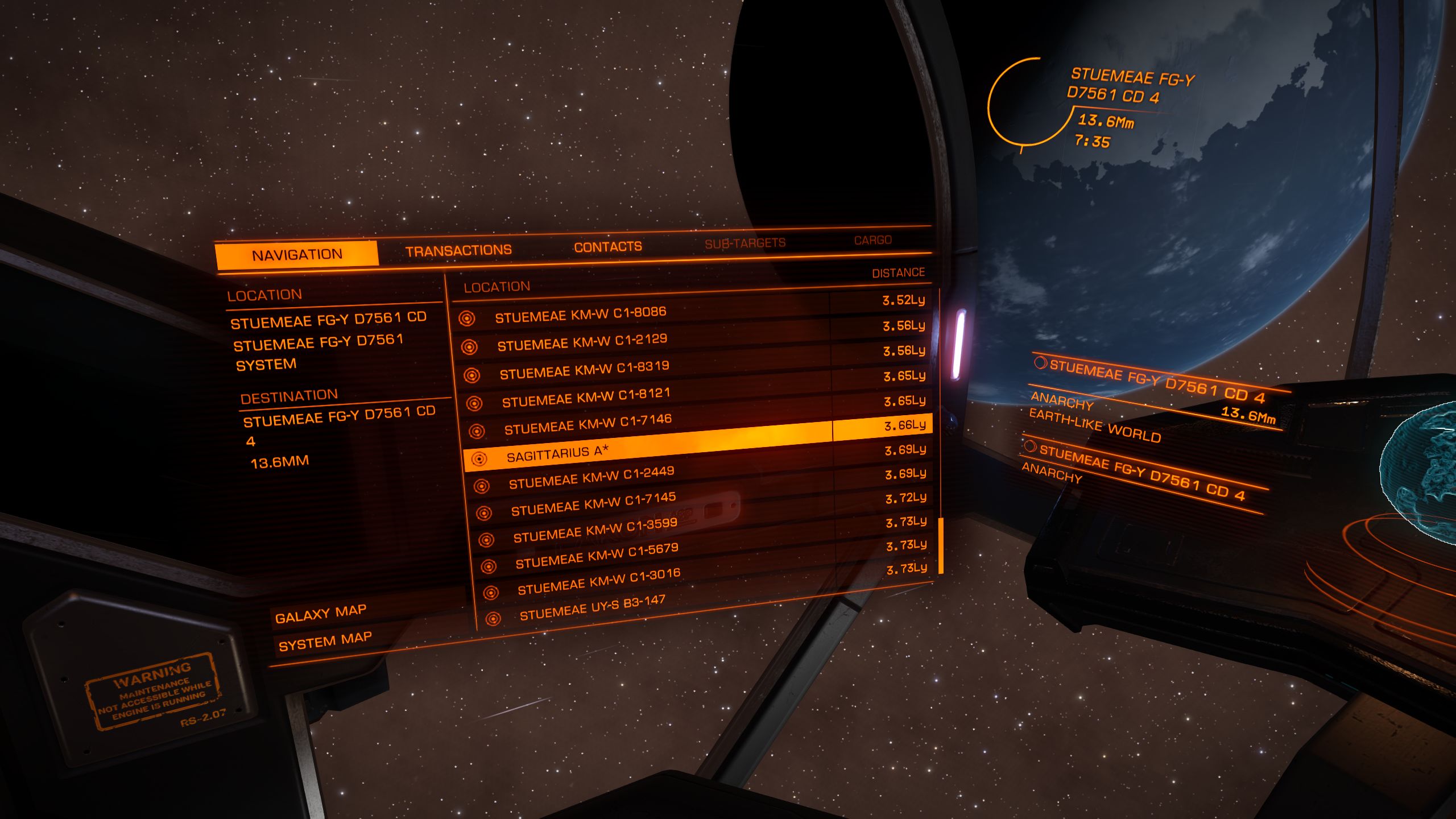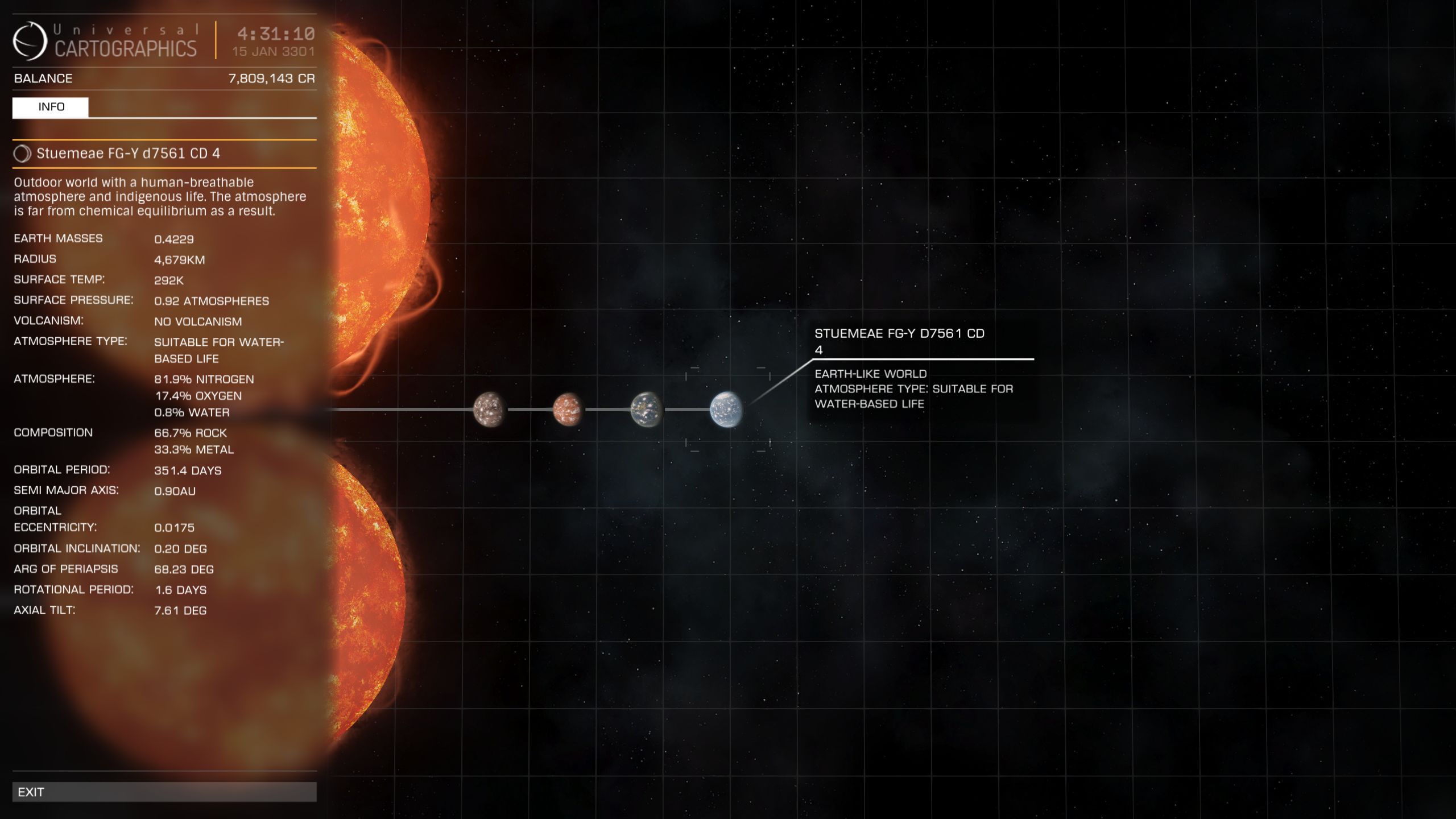Nice work but there are obvious errors:
1. Mass measured in radiuses and km
HEAVIEST RINGED BODY (NON GAS GIANT) - PLAA EURK MH-C C13-2 B 21 WITH A RADIUS OF 15,469km
2. LIGHTEST RINGED BODY - WREGOE BJ-X C28-34 5 WITH 2.9653 EARTH MASSES
but there is just below a body that is lighter and it's a gas giant!
LIGHTEST RINGED GAS GIANT - COL 285 SECTOR JX-P b20-2 6 WITH 2.8036 EARTH MASSES
3. You shouldn't add records that are worse than from bodies in Sol as they look preposterous, eg.
FURTHEST BODY FROM STAR - SETATI A 8 WITH A SEMI MAJOR AXIS OF 9.98AU
When eg. Neptun has it 29.81 AU in-game (and as I've already said SEMI MAJOR AXIS alone isn't a reliable measure of such distances)
4. SYSTEM WITH THE MOST RINGED PLANETARY BODIES - HIP 71526 WITH 5 RINGED PLANETARY BODIES
This is obviously wrong as it's contradicted by 2 positions above it. It's waste of your and our time to include such poor records - there is 30 ringed planetary bodies in THETA-1 MICROSCOPII! (record for MRHATMAN)
SYSTEM WITH THE MOST RINGED GAS GIANTS - ALNIYAT WITH 6 RINGED GAS GIANTS
Really? When you have shown THETA-1 MICROSCOPII and there is 15 ringed gas giants? BTW, 6 of them are Helium-Rich gas giants (7 in total - and I thought mine with 5 was impressive) and 5 of them class III gas giants. There are also 3 ringed water worlds (4 total), 11 ringed high metal content planets (14 if you include water worlds as they are over 32% metal, as well) (records for MRHATMAN)
5. SYSTEM WITH THE MOST GIANT STARS - SIGMA ORIONIS WITH 4 GIANT STARS
SYSTEM WITH THE MOST DWARF STARS - S 171 43 WITH 13 DWARF STARS
These category are entirely wrong, I think - are you sure it would be counted in a right way as eg. O2V is also a dwarf? What do you consider as giant stars? Are they just the one called giants or super and hipergiants, as well. Are subgiants also included? What do you consider as dwarfs - this category could be much more diversified: white dwarfs, brown dwarfs, red dwarfs, yellow dwarfs, blue dwarfs... There are also subdwarfs... And in many circumstances you can't say whether or not it's a dwarf just by showing the System Map - you have to show info from the Galactic Map but the problem is all those stars won't be shown in the Star Type window if they are too numerous (they all won't fit) so how you could even count them.
6. SYSTEM WITH THE MOST ROCKY PLANETS - HIP 71526 WITH 10 ROCKY PLANETS
SYSTEM WITH THE MOST ROCKY ICE PLANETS - WREGOE LO-Z d13-130 WITH 3 ROCKY ICE PLANETS
Really? There are even planets with more rocky and rocky ice moons among the current records... Aren't moons considered as eligible here?
7. SYSTEM WITH THE MOST METAL RICH PLANETS
SYSTEM WITH THE MOST 100% METAL CONTENT PLANETS - S CARINAE HAS 14 100% METAL CONTENT PLANETS
In the current version of the game those 2 are the same category. Problem is it has never been proved, properly.
8. SYSTEM WITH THE MOST BODIES WITH AN ATMOSPHERE - PLAA EURK MH-C C13-2 WITH 13 BODIES WITH AN ATMOSPHERE
You count it wrong as all gas giants have atmospheres. Should we have so difficult to prove records?
9. SMALLEST (and probably LIGHTEST) METAL RICH PLANET is the smallest planet found by carazvan: S171 19 A 6 B A
10. HOTTEST TERRAFORMABLE PLANET - COL 285 SECTOR JX-P B20-2 4 WITH A TEMPERATURE OF 295K
COLDEST TERRAFORMABLE PLANET - SYNUEFE CG-W C18-7 A 1 WITH A TEMPERATURE OF 1,387K
Shouldn't it be the other way around?
11. LARGEST TERRAFORMABLE PLANET - COL 285 SECTOR JX-P B20-2 4 WITH A RADIUS OF 4,974KM
HEAVIEST TERRAFORMABLE PLANET - COL 285 SECTOR JX-P B20-2 4 WITH 0.5128 EARTH MASSES
Is this supposed to be impressive? A largest/heaviest terraformable that is actually much smaller/lighter than Earth? I ask again: why waste time including such "records"? There are so many much larger, eg. 5 out of 7 in my Praea Euq TT-A d31 - I won't even consider them impressive enough...
There are more obvious ones but my time has unfortunately ended for now...
Little corrections:
1. COLDEST AMMONIA WORLD - PIPE (STEM) SECTOR YO-Z B0 7 WITH A SURFACE TEMPERATURE OF 184K
you've opted for so complicated name when
mine was showed before it and was actually a little bit colder - HIP 10889 B 5 WITH A SURFACE TEMPERATURE OF 182K
2. You somehow missed my lightest and smallest terraformable from
this post. It definitely wasn't a joke

It could also be:
COLDEST TERRAFORMABLE PLANET - SYNUEFE DH-M B39-1 AB 3 WITH A TEMPERATURE OF 238 K
3. Heaviest/Lightest system shouldn't be among the records as it's quite difficult to count and even more difficult to prove.
4. SMALLEST BLACK HOLE, SMALLEST NEUTRON STAR, should not be among records as they usually are under 0.0000 solar radiuses - perhaps when they change units here.
5. HIGH METAL CONTENT PLANET WITH THE MOST MOONS - WREGOE LO-Z d13-130 C 2 WITH 1 MOON
RINGED STELLAR BODY WITH THE MOST BODIES - ANTARES B 9 WITH 11 BODIES
I've already shown you better ones at the end of
this post, though it's still not especially impressive.
My turn in records:
HOTTEST A-TYPE STAR - MU FORNACIS WITH A TEMPERATURE OF 12,319.00 K
YOUNGEST A-TYPE STAR - MU FORNACIS WITH 1 MILLION YEARS
SMALLEST A-TYPE STAR - HIP 9464 C WITH A SOLAR RADIUS OF 1.2455
LIGHTEST A-TYPE STAR - HIP 9464 C WITH 1.3477 SOLAR MASSES
OLDEST A-TYPE STAR - HIP 9464 C WITH 3,245 MILLION YEARS
LARGEST A-TYPE STAR - CANOPUS WITH A SOLAR RADIUS OF 71.4
HEAVIEST A-TYPE STAR - CANOPUS WITH 9 SOLAR MASSES
COLDEST A-TYPE STAR - CANOPUS WITH A TEMPERATURE OF 6,517.00 K
HEAVIEST F-TYPE STAR - HR 473 WITH AT 2.6289 SOLAR MASSES
HOTTEST F-TYPE STAR - HR 473 WITH A SURFACE TEMPERATURE OF 10,327.00 K
LIGHTEST G-TYPE STAR - VEROANDI A WITH SOLAR MASSES OF 0.4844
SMALLEST G-TYPE STAR - VEROANDI A WITH A SOLAR RADIUS OF 0.6251
COLDEST G-TYPE STAR - VEROANDI A WITH A SURFACE TEMPERATURE OF 3,649 K
OLDEST G-TYPE STAR - VEROANDI A WITH 10,926 MILLION YEARS
HEAVIEST G-TYPE STAR - HIP 9960 A WITH A SOLAR MASS OF 1.6523
HOTTEST G-TYPE STAR - HIP 9960 A WITH A SURFACE TEMPERATURE OF 8,091.00 K
SMALLEST M-TYPE STAR -SYNUEFE UP-F B43-1 B WITH A SOLAR RADIUS OF 0.3243
LIGHTEST M-TYPE STAR - SYNUEFE UP-F B43-1 B WITH 0.1836 SOLAR MASSES
COLDEST M-TYPE STAR - SYNUEFE JT-Y B46-0 A WITH A SURFACE TEMPERATURE OF 2,005.00K
OLDEST M-TYPE STAR ICZ CQ-Y C12 B WITH 17,785 MILLION YEARS
LARGEST T TAURI - NU FORNACIS B WITH A SOLAR RADIUS OF 2.0634
HEAVIEST T TAURI - NU FORNACIS B WITH A SOLAR MASS OF 2.8437 SOLAR MASSES
HOTTEST T TAURI - NU FORNACIS C WITH A SURFACE TEMPERATURE OF 10,334.00 K
COLDEST EARTH LIKE - Synuefe ZC-H D11-51 4 WITH A SURFACE TEMPERATURE OF 262K
SMALLEST TERRAFORMED BODY - LTT 9387 A 1 WITH A RADIUS OF 2,866 KM
LIGHTEST TERRAFORMED BODY - LTT 9387 A 1 WITH 0.0885 EARTH MASSES
HOTTEST WATER WORLD - HIP 11821 BCDE 4 WITH A SURFACE TEMPERATURE OF 461 K
WATER WORLD WITH THE HIGHEST SURFACE PRESSURE - HIP 9955 A 3 C WITH A PRESSURE OF 335.20 ATMOSPHERES
COLDEST WATER WORLD - HIP 7693 A 4 WITH A SURFACE TEMPERATURE OF 243 K
SYSTEM WITH THE MOST CLASS V GAS GIANTS - BETA SCULPTORIS WITH 4 CLASS V GAS GIANTS
LIGHTEST GAS GIANT WITH AMMONIA-BASED LIFE - KABUGA 7 C WITH 2.5440 EARTH MASSES
SMALLEST RINGED GAS GIANT - KABUGA 7 C WITH A RADIUS OF 13,152 KM
LIGHTEST RINGED GAS GIANT - KABUGA 7 C WITH 2.5440 EARTH MASSES
HEAVIEST CLASS V GAS GIANT - 72 RHO CETI 3 WITH 3,711.1277 EARTH MASSES
HEAVIEST RINGED GAS GIANT - 72 RHO CETI 3 WITH 3,711.1277 EARTH MASSES
 .
.





































